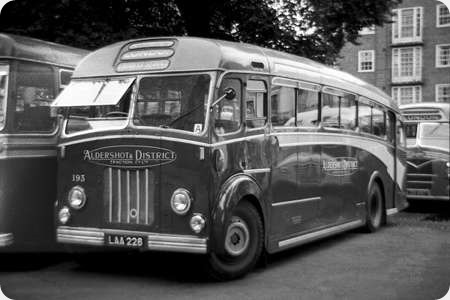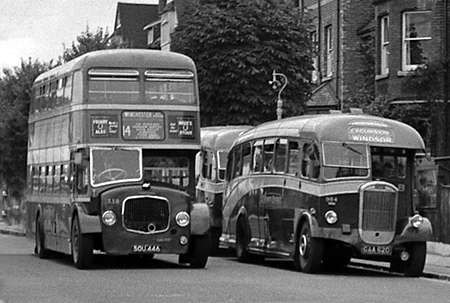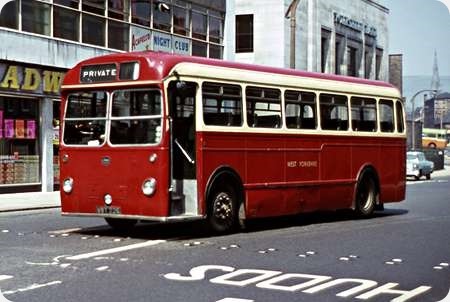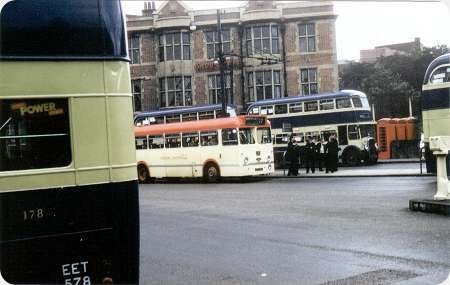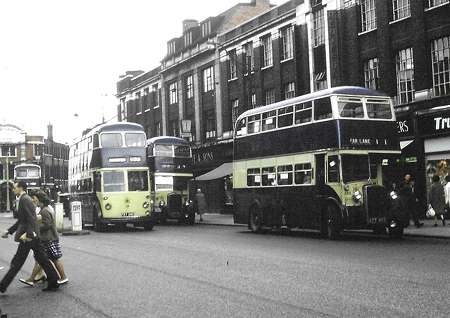Aldershot & District – Dennis Lancet – LAA 228 – 193
Aldershot & District Traction Co
1953
Dennis Lancet III J10C
Strachan FC38R
In 1948, Aldershot & District took delivery of fifteen Dennis Lancet J3 coaches with Strachans C32R bodies. These replaced the externally very similar Lancet II/Strachans C32R vehicles of 1937-38, the main difference being the longer bonnet of the Lancet III which housed the 7.58 litre O6 in place of the 6.5 litre O4 in the pre war model. These post war machines were very fine coaches giving a high standard of refinement. The 24 valve, wet liner, O6 engine was probably the smoothest running diesel engine of all time, and, coupled with the Dennis ‘O’ type five speed gearbox, it was capable of excellent performance on the road. However, by the early 1950s, the traditional half cab, heavy duty, front engined coach was regarded as passé in major fleets, having been supplanted by the fashionably new underfloor engined machine. Even small independents had begun taking the superficially more modern Bedford SB. In 1950, Aldershot & District bought one of the only two Dennis Dominants ever completed (a third was constructed in chassis form only and subsequently dismantled), but had been obliged to look elsewhere for an underfloor engined chassis when Dennis decided not to produce that model in quantity. In 1953, wishing to upgrade its image, but still undecided about the underfloor configuration, Aldershot & District tried out a number of underfloor engined machines from a variety of manufacturers – Guy (Arab LUF), Atkinson (PM 744 & 745), Leyland (Tiger Cub) and Dennis (Lancet UF). Surprisingly, in view of later developments, AEC was not represented in these trials. The story of the Aldershot and District demonstrators may be found at this link.
Instead the company sought to update the coach fleet with 15 full fronted examples of the 30 feet long and 8 feet wide J10C Lancet, with Strachan FC38R bodywork, Nos.188-202, LAA 223-237. These were attractive coaches of traditional appearance, though the effect was spoiled slightly by the cheap looking wire mesh grille, the apparent frailty of which seemed to to be endorsed by the dents that it soon acquired in service. Like all Lancets, these coaches were excellent, smooth running, reliable machines, though the drivers’ cabs reputedly became unpleasantly hot, particularly so in the summer months. Aware that these coaches presented an outdated image in a world increasingly dominated by modern, underfloor engined vehicles, Aldershot & District succumbed in 1954 to the lure of the AEC Reliance, purchasing twenty-five examples of the MU3RV model with the 6.75 litre AH410 engine. Angular Strachans Everest C41C bodies were fitted with a high floor level and corresponding waistline. The arrival of the Reliances resulted in the relegation of the full fronted Lancets from regular express work to other duties, and they were all withdrawn in 1963 after a relatively short life of ten years. In the photograph, taken at Victoria in 1960, No.193, LAA 228, its windscreen significantly open wide, is laying over in the company of one of the Strachans bodied Reliances. Behind is LCD 857, one of Southdown’s Beadle rebuilds with FC35C bodywork, 30ft long and 8ft wide on 7ft 6ins chassis sections. This coach was constructed using the units of pre war Leyland Tiger TS8 EUF 96, and retained the 8.6 litre oil engine. Like the full fronted Aldershot & District Lancets, this vehicle (and its fellows) was sold in 1963.
Photograph and Copy contributed by Roger Cox
04/11/19 – 06:15
How surprising in 1953 for such buses/coaches to be delivered to a "substantial" company? Times had already moved on e.g. Ribble with its Leyland/Leyland coaches in 1951 and Tilling with the LS/ECW "beauties" in 1952. A nice story Roger, thank you.
Stuart Emmett
05/11/19 – 06:12
This picture, taken in 1961 in The Grove alongside Aldershot Bus Station – now long gone, the current bus station is a pitiful apology of a facility – shows the Winchester outstation based 1958 Dennis Loline I 338, SOU 446, with East Lancashire H37/31RD body, passing a pair of the fine 1948 Lancet III coaches with Strachans C32R bodies; these were displaced by the 1953 full fronted machines from express duties to private hire and excursion work. 984 GAA 620 and its fellow fourteen coaches were all withdrawn in the year of the photograph, 1961; the Loline survived in A&D service for a further ten years.
Roger Cox
08/11/19 – 10:27
Full-fronted Lancet J10C has thankfully been in preservation for some years. There remains work to be done before we see its welcome appearance at rallies. Thanks, Roger, for the mid-’50s demonstrators link: before reading Eric Nixon’s piece I had no idea how many types had been assessed. The Atkinson is my biggest surprise! But I still can’t help wishing that, like East Kent, they had gone for underfloor Lancets.
Ian Thompson
11/11/19 – 07:09
I think the half cab Lancet III in Roger’s second photo looks much better than this last fling from 1953. Obviously an additional window bay has been inserted to achieve the extra length but it causes the body to droop excessively towards the rear giving a strangely unbalanced look. The side flash doesn’t help either!
Chris Barker
